Posts Tagged Television
Dexter’s Laboratory took a simple phrase, and trope, to its logically dark conclusion
Posted by kjohnson1585 in Animation, Animation Breakdown, Television, Uncategorized, Writing on August 4, 2017
Dexter’s Laboratory (S1E9) – Doll House Drama… by ClassicCartoonChannel
Dexter’s Laboratory staked its claim in the animation landscape with one simple phrase. It wasn’t a meaningful phrase, and by itself, it wasn’t particularly funny. It’s a phrase that’s pretty innocuous, a nothing of a phrase that nevertheless feels like the culmination of everything the show was trying (and managed) to be. That phrase, you may have guessed, is cheese omelet, or as you would say in French: “omelette du fromage.”
Dexter’s Laboratory is perhaps one of the most important cartoons of the mid 90s, a bold, stark, animated show defined by the direct, specific use of simple shapes, harsh editing, and dramatic visual irony. It’s a show comfortable with a certain “throwaway approach” to character design consistency: characters could change size, even shape, as long as the gags would hit, and hit hard. Dexter’s lab itself always changed, never once looking the same from episode to episode – even how you entered the lab changed through the series (shades of the various, comical ways Perry the Platypus would enter his own underground hideout in Phineas and Ferb). Most animated shows in the post-Dexter’s Laboratory world will mimic or copy the look but not the style, and certainly not the subject, creating a lot of basic, sharp-angled, sloppy shows that more or less were done as a cost-cutting maneuver. Dexter’s Laboratory was (one of the) first, and Genndy Tartakovsky honed his skills here, sharping his timing, pacing, and framing to create iconic sensibilities in the more critically-known Samurai Jack.
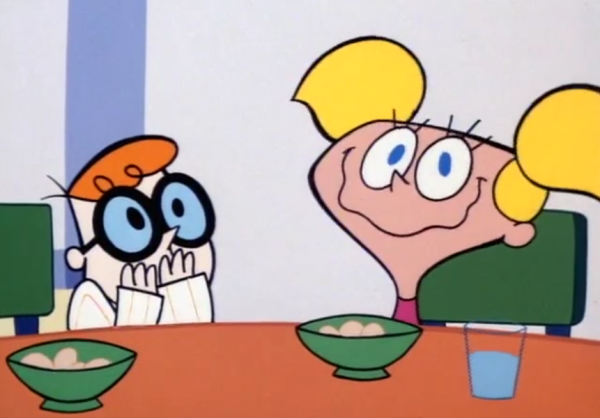
We cannot dismiss what Dexter’s Laboratory was doing when hit CN all those years ago. It’s difficult to think about it now, with so many cartoons on the air these days, but even back then the show was playing smart and coy with what kids animation was doing, and could do. It played into a lot of animation tropes, both Western and Eastern, only to undercut them with a narrative twist, a comically sudden beat, or with something so average, so anti-climatic, that you found yourself wondering if you somehow missed the actual ending. Even back then, cartoons were doing some interesting and crazy things, mostly in terms of narrative commitment, but Dexter’s Laboratory looked backwards towards classic cartoon formatting and style for inspiration. Episodes will be split between several shorts, most about Dexter and his family, but other character and show types, including “The Justice Friends” and “Dial M for Monkey.” The rhythms of the entire show will move somewhat like Rocky & Bullwinkle, an assortment of short animated bits, a format mimicked and copied all throughout the Hanna-Barbera era.
Watching the entire episode – which includes “Doll House Drama,” “Krunk’s Date,” and a brief sequence parodying comic book ads disguised as actual comics – I’m struck by the degree in which Dexter’s Laboratory really engages in that classic format. Not just in the ideas of each episode, but even in the stunted movements and somewhat off-kilter edits. The rhythms would definitely be familiar to those who grew up watching something like The Banana Splits or Yogi’s Gang. “Krunk’s Date,” in particular, utilizes a lazy, “limited laugh track” to ostensibly shore up the comedy, but is obviously used ironically here. Dexter’s Laboratory is more committed to its comic beats here than those shows would ever be, and those first two episodes ends on somewhat odd, downbeat gags that feel different than the “sad trombone” gags of its predecessors.
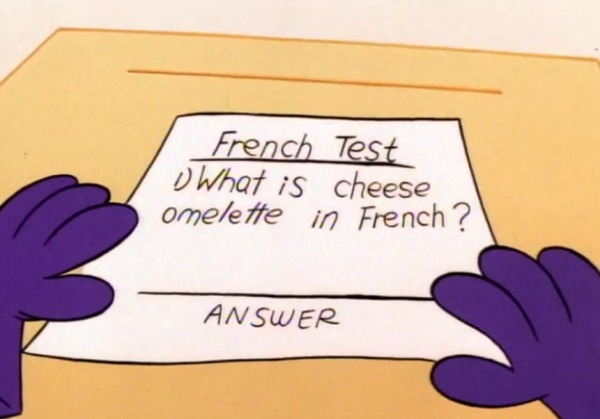
Then we get to “The Big Cheese,” an episode that hilariously steers into its one-note gag to an insane degree – only to snatch it away, hard and without warning. Rewatching this episode, I’m also struck with how patient Tartakovsky builds the gag. Dexter puts off his French homework to work on other, “more important” scientific pursuits, although some are really generic chores with complicated names. There’s no “panic” when Dexter realizes he still has to study – he just decides on a fairly normal trope – overnight osmosis. Playing a record that pipes French-lessons into his ears while he sleeps, the record skips over and over when it hits one central phrase: omelette du fromage. By the 90s, we were well in the CD/cassette era, so Dexter using a record for this feels silly, but it is central to the joke, and Dexter has been shown to disregard a lot of basic ideas for the pursuit of higher intelligence. Obviously his arrogance will prove to be his downfall, but “The Big Cheese’s” idea of a downfall is brutal.
Tartakovsky is fully aware of the trope in play, in how most shows would have its main character work around his situation to avoid being caught in one-phras-only mode. So Tarakovsky immediately has Dexter get caught. It’s by his sister, Dee-Dee, and she begins a comic repetition of her own: “That’s all you can say!” she sing-shouts, over and over, and at this point, it’s amusing. There is also a forewarning nature to it, specifically when she pops up during the montage, a sign of bad things to come. But before that point, that montage is a doozy. Montages are a dime a dozen in cartoons, but here, Tartakovsky escalates the absurdity of the situation with some impressive decision. He even starts the absurdity with a test with one single question, then ramps things up in more and more ridiculous ways. Some are a bit obvious, like omelette du fromage being a French town somehow, and the girls in the class being smitten by his use of French. The potential bullies suddenly being scared off by Dexter’s use of the phrase, however, is such a random development, precisely because unlike the previous gags, this one completely lacks any reason to have occurred.
The combination of “maybe this could happen?” and “no way this could happen” results fill up the rest of the montage. Dexter brings world peace. He becomes TIMES Man of the Year. Parades are thrown in his honor. He has a number one hit song that’s composed of, one assumes, just that phrase. It’s so dumb, but there’s a perverse comic value in seeing all the ways Tartakovsky takes this singular bit, pushing and pushing and pushing it to hilarious lengths. And it’s all pretty fantastic… up until the final moments. (I do want to point out that before Dexter enters his home, he kisses a baby, then drops it, as cameras flash. I feel like that’s a key visual sign for the next scene, but I think I’m really over-reading what amounts to a simple, hilarious joke-within-a-joke).
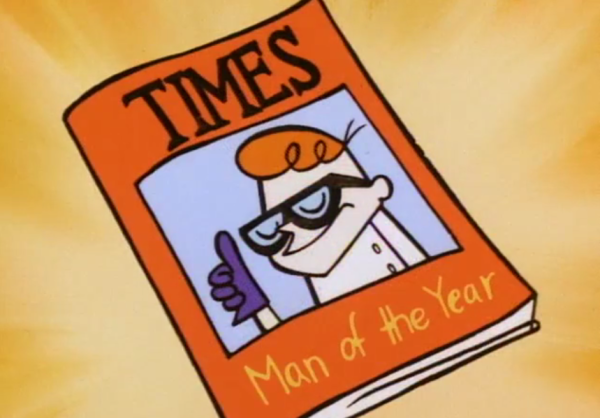
It’s in those final moments though that things turn against Dexter – the karmic, schadenfreude moment that takes thing perhaps too far. Outside his lab, the young scientist learns that his solitary word usage isn’t the password to enter his lab. His computer not only locks the lab up tighter, it begins a self-destruct sequence. Dexter, panicking and in literal tears, shouts in desperation, but only “omelette du fromage” can escape his lips. And then his sister pops up. She begins reciting in comically dark fashion the very phrase she’s been repeating all day, “That’s all you can say.” Unhelpful and useless. And if you were expecting a saving grace, a final reprieve that saves Dexter’s lab and allows the child to learn a lesson in the relative clear… it does not come. The computer says “one.” The lab completely explodes. Dexter and Dee-Dee are visible through a massive hole in their house. Fade to black. THE END pop on screen, “That’s all you can say” echoing silently in the background.
It’s pretty ridiculous in a sense. It’s a cartoon, and developing sympathy for Dexter and his lab, particularly after an episode where he skates by on a French phrase through success after success, comes across as a little weird. Dexter doesn’t really hurt anyone (except that baby, which maybe is worth discussing), and other than his hubris, there’s the question of whether the karmic destruction of his life’s work is proportional punishment to his behavior. It really isn’t his fault that he got famous off the phrase. There’s a lot to be said about the public’s infatuation over such a dumb, singular concept – and I should remind you that this episode took places years before social media and “going viral” was a thing. [I really want to do a piece about how cartoons portray crowds and public reactions; there’s a difference between mob mentality and blindly following a large group for gag purposes.] This is reminiscent of The Simpsons’ “Bart Gets Famous,” in which Bart experiences the highs and lows of success brought about by his own oft-repeated motto “I didn’t do it,” but that show had the time to draw into the reluctance and complexity of Bart’s feelings towards his entire “fifteen minutes.” With “The Big Cheese,” Tartakovsky had three minutes to get to his point, and he focused on the perfect visual display of the rise and fall of success – the fall embodied in a dark, destructive moment that shocked a young generation.
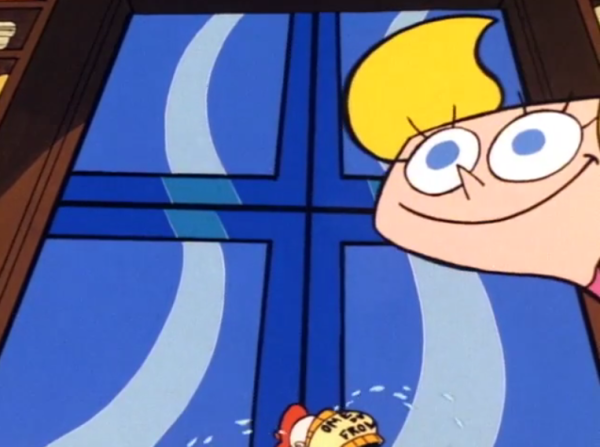
Perhaps “proportional punishment” isn’t really a thing. Sometimes you find yourself so caught up in something that you fail to realize how far you are from the things you once held dear – and they’re gone in an instant. Tartakovsky made his point clear, and it left many people with only “omelette du fromage” and “that’s all you can say” dancing in their heads, in the midst of a dark, music-less void. The very premise of the show, Dexter’s Laboratory, was gone in an instant, leaving kids to wonder if, and why, such a bleakness was warranted. As an adult, we wonder about it still.
NEXT: Rescue Rangers’ uses a badass Gadget Hackwrench to contemplate the value of religion in “The Case of the Cola Cult.”
Niko and the Sword of Light Proves Adventure Tales Still Have Merit
Posted by kjohnson1585 in Animation, Television, Uncategorized, Video Games, Writing on August 2, 2017
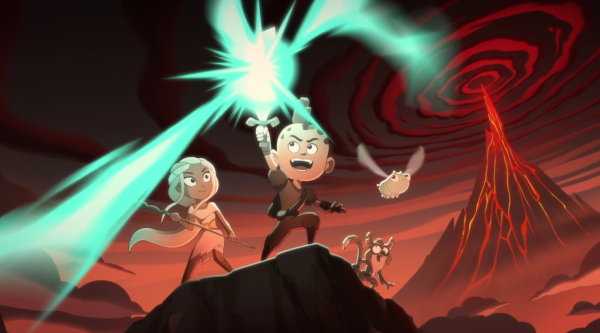
Niko and his party (which include Princess Lyra, Mandok, and Flicker) run into a stranger in the middle of the first season of Niko and the Sword of Light. The stranger is a talented, effective fighter, a rogue-type mercenary, and he proves to be a better warrior than Mandok. So of course, Niko and Lyra heap praise on this stranger while Mandok stews in jealousy. This stranger makes an important and needed contribution to the team. Every time you think he’ll betray everyone, it turns out to be a red herring. Lulls viewers into a certain set of expectations. But we’re adults, and we’ve seen these kinds of long-term adventure tales before: Lord of the Rings, The Last Airbender, hell, even The Matrix. We know that this stranger will indeed turn out to be a traitor, right as the team is at its most vulnerable. We see it coming, but even still, it’s a striking moment.
It’s a simple moment, too: it’s devoid of any massive complication or overwrought details. There’s depth to the characters, and the world they inhabit, but that depth is important insomuch as it simply provides obstacles and/or methods to overcome them. In other words, don’t expect to delve deep into lore or culture in your fan theories or thinkpieces. But what this does prove is that the basic storytelling tropes of these large, globe-trotting adventure tales can still be effective and powerful and entertaining, especially to younger kids who are new to these kinds of tales. We often forget that there’s an entire demo that hasn’t seen, watched or read these kinds of stories, so they don’t know how to look for the tell-tale signs of betrayal, or homages to Westerns or horror tropes, or the various ways high-end fantasy portrays itself. The twists are obvious but still work, and it helps that the animation is gorgeous, with big, expansive backgrounds and some of the tightest, sharpest action sequences since The Legend of Korra. All to get you into a story that we have witnessed time and time again.
The core of such a story is still engaging though, and Niko and the Sword of Light commits to it in ways that keep it fun and light AND dark and mysterious at the same time. It keeps things moving, a consistent story that manages to keep up along thirteen entire episodes, finding small twists and story beats to maintain that momentum. To be clear, those twists and beats aren’t anything new – besides the aforementioned obvious traitor, there’s the “flawed former hero,” a rally-the-troops moment, temptations galore, and many, many low points before they become inspirationally high. Discerning viewers already on the fence about watching a low-key adventure tale may also be bothered by the show’s humor, which isn’t childish per se, but it is rather basic and simplistic, and at its worst, forced into moments where the dramatic tension is thusly ruined. But there’s a reason these adventure tales are told so often: the wonder, magic, mystery, and action still can delight an audience.
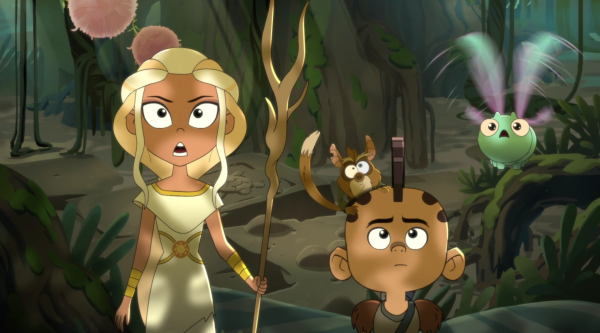
The highest point of the show is its action scenes. Dynamic, vibrant, and engaging, Titmouse has always excelled at crisp, clear, and exciting action, and they bring it to the table here. Watching Niko and Lyra do battle with huge, grotesque monsters is a treat, and it’s both amusing and impressive to watch a ten-year old boy move like a skilled gymnast warrior to dodge massive tentacles or flailing tails. And as great as the monster battles are, the show’s most rewarding fight takes place in episode nine, “From the Cliffs of Catastrophe to the Pools of Destiny” (every location is named in such a fashion, and the show more or less lampshades this convention in many scenes in which characters spout out a series of locales with similar names). Not to spoil too much, but the action here is absolutely wild, arguably the best balls-out battle since the final episode of The Last Airbender. I should also mention that, in a way that’s kind of hard to describe, the action scenes feel very much like you’re actually playing a game – like you’re pressing the buttons to actually perform the specific combos, special “light” moves, and various slick-ass dodges you see on screen. Part of that is because, yes, Niko and the Sword of Light is based on a mobile game of the same name. But it’s also because of how specific Niko’s moveset is, how he moves in action, and how he engages in actual battle. Each swing, each attack, each shouted-out-loud special move feels like an input and has an… aesthetic tactile result and response while watching. I know that saying a show feels like a video game is often negative, but here, it’s absolutely a positive.
And even if Niko and the Sword of Light is mostly a barebones adventure tales with slightly-overwrought gags and tightly storyboard action, there is just enough backend details for those who prefer to read deeper into the world. The various characters that our heroes meet lean a bit on the silly end of their characterizations, but they still feel like a culture with a long history, like the “meercoons,” who have chronicled the failures of past champions over centuries. The central story itself, in which humanity froze itself in safety while guiding said champions over such a long history to fight the darkness, grows more unique and darker over the season, with episode four’s “From the Phantom Woods to the Mountains of Misery” an excellent portrayal of exposition. (It’s even explained why Niko himself is only ten, since the crystal from which he was born was shattered too early, but he still speaks/acts like an older hero, which explains the awkward-sounding dialogue – although I can’t say that Andre Robinson’s VO work isn’t flawless.) The monsters feel like the product of arbitrary “scary” design principles until the main villain, Nar Est, admits that his monstrous creations are just his artistic flourishes. My favorite detail occurs at the Pools of Destiny (episode nine is arguably the show’s best): vague spoilers, but the Pools aren’t what they seem, a product of hyped historical precedent.
And there’s Niko and Lyra themselves. The entire crew grows closer over the course of the adventure but there’s a clear thematic understanding that occurs between the champion and the princess, an understanding that underlies the entire season. Niko’s desire to help all the various groups of people they encounter runs counter to Lyra’s overall goal of reaching and defeating Nar Est. Centuries of failure stem from overall acts of kindness for even the smaller groups of people they meet. When Niko starts to help them, he is the first of a long line of champions to offer assistance for the common person, and it leads to some small but pronounced surprises towards the end. It’s an ending that perhaps culls too much from The Last Airbender and Legend of Korra – two obvious influences, along with Samurai Jack (Nar Est is basically Akku) – but it is satisfying nonetheless, the end result of an adventure story that excels in ways both small and large. I wish the show was deeper and, perhaps, darker, but I also worry that such a direction would force it into a “gritty, serious” state, and that is not a direction that would work for such a show. Still, a bit more depth to some of the specific characters are necessary – like the three “opposterums” whose desperation to stay as a combined, cursed monster really needed exploring – and a better control over the tonal dissonance between its dramatic and comedic moments. The core storytelling is still strong however, and adventure tales like Niko and the Sword of Light still can inspire imagination and wonder in children and adults like the various tales before it.
The Amazing World of Gumball Recaps: “The DVD” and “The Responsible”
Posted by kjohnson1585 in Animation, Television, The Amazing World of Gumball Recaps, Writing on July 31, 2017
I’ve been wanting to do episodic recaps for The Amazing World of Gumball for a while now. I’ve tried to convince a few of of the websites I freelance for to cover this show, but it never catches on. In the past year or two, the show has been gaining massive popularity – somewhat unfortunately, in the “I can’t believe they went there” fashion, but there are those who recognize it for its boldness, brilliance, cleverness, sharply dynamic animation, and flawed, enriching characters. Since mainstream critics won’t call attention to it (while frustrating, I do get it), I decided to tackle the show myself. I’m looking forward to it, especially as the show breaks from its original basic setup into a harsh, powerful, dramatic satire of a surprisingly put-together world.
The Amazing World of Gumball Season 1 Episode… by gumball-amazing
“The DVD” – B+
The Amazing World of Gumball will take some time to get to that point. It won’t push boundaries, or raise stakes, or truly commit to the honest, raw, and genuine emotional state of its central characters until some point in the second season. By that time the animation will have changed, and with that, a clearer observation of who and what the characters and the world of The Amazing World of Gumball can be. But we shouldn’t discount what occurs in “The DVD.” The basic, core characterizations are here: Gumball is the awkward kid who’s blindly committed to bad ideas, Darwin is the nice brother who cowtows to Gumball’s whims while simultaneously tries to talk him out of it, and Nicole, Gumball’s mother and the show’s early and continuous standout, is the stereotypical mother figure with a hilariously overbearing, militant streak. The show will complicate those attributes further overtime. But for now, “The DVD” is a basic fun lark, a taste of things to come.
One fascinating thing is that the characters feel fully realized, if not fully formed, in the early going. The opening exchange, that very first joke of escalating passive-aggressiveness between Gumball and his mother, immediately provides the early glimpses of the specifics of the characters, and even a sense of the type of show The Amazing World of Gumball will end up being. The final line, in which Gumball suggests that this entire issue with the DVD is Nicole’s fault for having kids in the first place (and before Nicole showcases her iconic, individual strength by punching through a wall), hints at a level of adult humor that the show will grow more and more comfortable in utilizing as the show goes on. I’ll need to make a point though – “getting away with adult jokes” is not at all what Gumball should be recognized for.
No, the juicier material lies within the entire scenario in which Gumball and his brother Darwin attempt to avoid “the consequences of their actions” and attempt to return a fake DVD and ensure their mom never learns about it. It’s cartoony basics here, with jokes like a fake cardboard DVD, Darwin speaking a long line in Chinese that’s translated as a simple “No,” and an amusing scene in which Gumball finds himself deeply allergic to makeup. Yet Gumball will also get a bit harsher with its satire, like the scene in which the two lower-middle class brothers beg on the street next to an an actual homeless man. It’s a dark, pointed gag, in which the homeless man not so subtly points out the insanity of the situation. It’s also pretty fucked up that the implication is that Gumball and Darwin received more change than the person who actually needed it (symbolized by a ridiculous beatboxing scene, where the two siblings once again get change over the homeless man). Karma comes quickly once the man takes the change buys a scratch-off, and wins; when Gumball then asks for his four dollars back, the formerly-homeless man feigns no longer having any change on him. It’s brutal, especially once it becomes clearer that the Wattersons aren’t quite wealthy in their own specific ways, and Gumball will get incredibly more direct on this point later in the series.
The ending sequence is also a perfect taste of what Gumball will improve upon as the show goes on as well – an epic chase scene in which Nicole runs – and I mean runs – after her children in anger from the lies. Even this early in the animation, it’s a visual masterpiece, with an action-movie sensibility to the aesthetics, and props to making it clear that Nicole’s rage, while epic, can be on occasion hindered. It ends on a couple of generic but hilarious gags and tropes – Larry watches the DVD and sees a terrible Sweded version of Alligators on a Train, Nicole hears the confession and declares her love for them is universal, and she pays the $25 fee for the DVD. But then the Gumball goes for what will mostly be its signature move, the ironic ending, the narrative switch that will keep viewers on its toes: when the late fees add up to a whopping $700, Nicole, nice, calm, and loving, tell her children to RUN. It’s perfect, a symbolic freeze-frame shot that sums up the show in a nutshell.
“The Responsible” – B
“The Responsible” introduces Richard Watterson and Anais Watterson. Both characters will go through some changes and deepening over the course of the show, particularly Richard, who will take a quite a while to make into a more workable character. Richard here is portrayed as the bumbling idiot, the comic relief who hates pants and whines like a manbaby. The Amazing World of Gumball as this point is still in its infant stages. It won’t really grasp its identity as a firm, (hyper)realistic, (dys)functional family until later. Right now, it’s mostly separate characters that are a family in name and gags only. Richard is a joke and Nicole is a machine, and Darwin and Gumball are the two who get into various scrapes. In this case, it’s how they take care of their baby sister, Anais, after Richard screws up in ordering a competent babysitter.
Anais is more solidified as a character. She will get even better, more or less contrasting her underrated genius and strategic thinking with her abject loneliness, youthful desperation, and the limits of her self-reliance. Here she has to struggle with her idiotic brothers as they go overboard with their protectiveness. She can’t watch TV (or specifically, commercials) because they’re corrupting, so she gets to witness Gumball and Darwin bash the TV set to death with bats. She can’t read a book, because she might get paper cuts, so Darwin jumpkicks it out of her hands. She can’t eat solid food (what her siblings pass as food anyway), so they chew it up and give her the chum. Rightfully, she knocks it back into their faces.
“The Responsible” is a fine, even visually great episode, with some great little details to keep your attention. It’s a great showcase, for example, when Darwin swims in the flooded house with ease, reminding you that he is indeed a fish (who enjoys his fishchips now and then). A steady shot in which Darwin and Gumball chase Anais around the living room is fantastic, mostly because it allows the space to be utilized in a lot of fun ways, sans cuts or edits. It doesn’t get a chance to get much deeper or exploratory though, mostly as an episode to enjoy the fruits of its animated labor. Its most cartoony moment is when they three pop out the chimney in a geyser and land hard on the sidewalk below, with only scratches. Yes, this is a cartoon, so this is a difficult line to walk, but while at this point The Amazing World of Gumball is more Looney Tunes, it’ll gradually pull away from that tone just enough so that stakes and threats will be harsher and more dangerous, eventually mastering it perfectly.
“The Responsible” also gets into Gumball’s narrative self-awareness, as this episode is all about the value and importance of responsibility (similar to “The DVD,” which is also why it’s a step down since it’s more or less a thematic retread). The lesson is learned, after a hellish experience, and the point is made when Gumball eventually accepts taking responsibility for the chaos… only to be unable to commit to it after staring into the flaming eyes of his mother. Gumball undercuts its lesson learning as every character ends up blaming something else for the disaster, eventually settling on the internet, which is part and parcel of the show’s ironic endings. But as the show goes along, that kind of undercutting will end up reaching some real, raw revelations that go being childish lesson learning, revelations that will be twice as significant as the basic ones. Claiming the internet is at fault is the show’s way of exploring the tendency of people to absolve themselves by pointing towards others who messed up (whataboutism), but The Amazing World of Gumball in time will provide much more bite to those kinds of endings. Which leaves this ending okay for what it is, especially this early in the show’s run, but once Gumball gets a firmer command on its voice, the perfect interplay with biting cynicism and genuine optimism, it’ll truly become one of television’s sharpest, most hilarious, most biting, and most effective programs.

